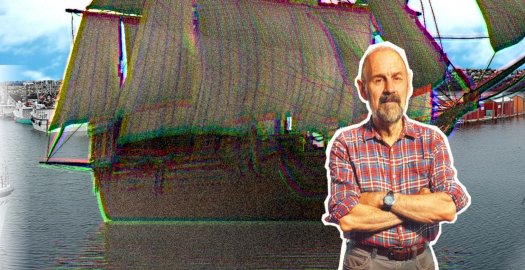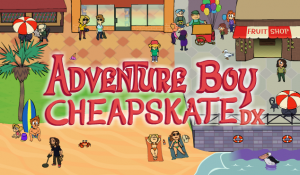Review for Clarevoyance

What ultimately makes a community flourish? Is a shared sense of place and a collective past enough? What happens if that past is slowly forgotten, and what can be done to ensure that it is remembered? These are just a few of the heady ideas informing Clarevoyance, a narrative-driven adventure by Chad Comeau’s Fring Frang Games, set in Comeau’s native Acadian region of Clare, Nova Scotia. An interesting mix of edutainment, mystery, and charming local flavor, Clarevoyance mostly succeeds at giving players a taste of the slow-paced life in Clare while solving a strange mystery and learning about the area’s distinctive history. Puzzle-lovers will find little to chew on, however, and its potential for full immersion is somewhat hindered by a dearth of opportunities for exploration and mundane graphics. Yet this largely conversation-based adventure with some light resource management is able to provide a few hours of enjoyable diversion in a place that has rarely, if ever, been the setting for a video game.
Players take on the first-person role of the unnamed protagonist, spending the summer in Clare with your Uncle Émile and Aunt Adèle. One evening, the three of you are on the beach, sitting around a campfire and reminiscing about old ghost stories told at summer camp. When you go to retrieve some more driftwood for the fire, you are accosted by a ghostly, shimmering figure and knocked unconscious. After recovering, you witness similar phenomena happening elsewhere around Clare, mainly in the form of glitching buildings and people from Clare’s past that seem to be passing through into the present. Apparently you are the only one who can see these apparitions, and so you set out to understand these ghosts of the past, and whether there are more sinister forces at work behind them.
I found the plot to be an intriguing fusion of the real and the fantastic, from going clamming in Grosses Coques to investigating the ill-fated ship Mary Celeste, just to name a couple of the more memorable highlights. Getting to know the local culture is part of the experience while solving the mystery at hand. The history of Clare specifically, and the Acadian people more generally, are emphasized heavily in the narrative, and figures such as Cy à Mateur, who supposedly made a deal with the devil in exchange for magical powers, make appearances to help you understand the role of myth and legends in Clare’s culture. Completing quests unlocks corresponding entries in the in-game library for more background information, and you can buy books at the local shops that open up further entries for you to read, detailing various aspects of Acadian culture and heritage. Unfortunately the quests themselves are somewhat superficial, so I feel like I got to know Clare only as a tourist, with very little context for how everything fits together.
The environments are quite varied, ranging from wharfs and wooded areas around the region, to local markets and homes in Concession and Saulnierville, to the Centre acadien, a major Acadian heritage research institution at the Université Sainte-Anne in Pointe-de-l'Église, to name but a few. The locales, however, are presented in a very plain, utilitarian manner that lacks the visual flair of other on-location-style games such as the Carol Reed series, despite having a similar photographic aesthetic. None of these complaints are deal-breakers, but a bit more attention to detail would have made a comparatively large difference in the feeling of “being there” that other similar indie games manage to deliver.
Another issue is that locations that might have been impressive set pieces for deeper examination, such as Sainte-Marie's Church, a distinctive landmark located at Université Sainte-Anne, and New France, called the Electric City for its early use of hydroelectric power, are barely featured except as scenery and the scene of a quest or two. Part of this is due to the fact that exploration isn’t really possible, with each stop being presented as a panoramic image you scroll across using the mouse at the edges of the screen to advance the view left or right somewhat. Directional arrows allow you to go directly to different areas in a given location. While you can enter businesses or move further into a scene (say, going from the road into a shop, or from the beach into the tree line), only a few such opportunities exist in each place, and the purpose is not to further explore the area but rather to allow you to begin a dialogue with the character(s) found there.
Characters you meet are varied as well, and all of them are portrayed by actual Clare locals, a charming touch that I enjoyed immensely. Although some of the period costumes used in certain segments are amusingly kitschy, I found it added to the homespun feel of the game. Given that these are ordinary people, not seasoned actors, don’t expect the voice-overs to be especially polished, either. However, hearing the unique Acadian French dialect from native speakers is an absolute treat. Note that there are only English subtitles, with no English audio option, although a few characters do speak English in the game.
Aside from investigating the various glitching sites around Clare, tasks you might encounter include such things as forging a special iron ring, looking into a case of stolen apples, and getting caught up in a moonshine operation. While there are quite a few things to do, there are no real puzzles to solve along the way, with most encounters simply involving chatting with the locals, getting the items needed to advance a quest, and attending different events as they come up, with the story opening up further as you go. I didn’t mind this at all, but those expecting a more brain-teasing set of objectives will likely be disappointed.
In place of puzzles, resource- and time-management are integral aspects of Clarevoyance’s gameplay. There are four resources to track: stories, time, money, and food. The first is crucial for progressing in the game, and completing quests is the primary way to acquire new and interesting stories. Exchanging these stories with the locals in dialogue, called “yarning,” can open up new avenues of investigation and clue you into various goings-on in Clare. Both current and completed quests are tracked in the journal accessible from the main drop-down menu at the top of the screen. While I am unsure whether I found every possible quest, a certain number of quests must be completed in order to reach the end; the game makes it obvious enough when this threshold has been reached.
Simulated 24-hour days and 7-day weeks are consumed in blocks of time by performing daily activities such as yarning, earning money, and traveling between locations, to name but a few prominent examples. At night you must return to your room at your relatives’ house to sleep, preventing you from doing anything else until morning. Money is useful for a number of purposes, such as buying food and paying certain characters. In addition to working at a local store, you can earn money in a variety of ways, including spending a few hours working a fishing boat for cash and helping to solve crimes with a private eye, the latter of which is a full-blown quest to complete. Some of these pay better than others, meaning that it can sometimes be beneficial to trade more hours of the day for higher pay.
While some of these activities might sound like they would involve minigames, with one prominent (and extremely simple) exception, most are activities in name only. To work at a store, for instance, you simply choose a dialogue option asking the owner for work, and confirming this option trades a few hours of the day for money. Certain tasks can only be done at particular times of the day, such as meeting someone to go to a cabin in the woods, or on specific days of the week, such as attending a community fundraiser. Some of these activities are related to quests you must complete to further progress through the storyline, but some are optional tasks that you can pursue only if you wish to do so. Realistically, however, you will want to complete as many of these quests as possible, optional or not, as it’s the primary way to gain some of the most valuable resources.
You consume food at the end of each in-game day, so having plenty to eat in inventory is important. Well-being is increased by completing activities like working out at the gym, spending time at the beach, as well as other activities that can be discovered throughout (but again, these involve menu options rather than actual tasks for the player to complete). Your well-being is drained in certain circumstances, such as investigating the dark happenings around Clare, and if it drops to zero, you will need to build up more before being able to continue. However, it does not appear that the game ends when running out of any resource, a welcome change from other resource-management games, where failure leads to a game-over screen. Instead, you simply have to wait to complete those tasks that require a certain resource until you have earned more of it.
Some gamers might blanch at the idea of having resource-management mechanics in an adventure game (including me, truth be told), but the way it is handled here is actually quite, well, manageable. While I had a close call or two when certain resources dwindled, it wasn’t especially difficult to gain them back. And the laid-back pace of Clarevoyance remains intact despite needing to be efficient with your time to get things done, take part in an activity, or to meet with someone to advance the plot.
To help you keep track of the time and date, there is a helpful clock in the menu bar at the top of the screen, and a community calendar in the drop-down menu that notes when important dates and weekly events are coming up. While I didn’t test it, there may be a few one-time-only events that do not repeat and could be missed if you are not careful. Navigation between Clare’s various towns is accomplished using a map accessible from the same menu bar, and depending on whether you have purchased certain upgrades, you will have a choice of modes of travel around town. Some, such as walking on foot, might take a couple of hours, while others, such as a bicycle, will reduce the travel time, allowing you to do more things in one day.
Other elements of the mouse-driven interface are similarly intuitive, with icons detailing the various resources you have and other pertinent information. Saving the game is based on a checkpoint system in which you can only record your progress at the end of the day, although the number of save files that can be created is unlimited. While this is frustrating on its own to a certain degree, it was compounded in my case by the presence of a technical issue in which the interface would become frozen, necessitating a forced exit and reloading of the last save game, which obliterated around an hour of my progress if it occurred close to the end of the day. I only encountered this issue a few times, but it would have been less consequential if you could save at any time or the checkpoints were more generous.
Graphically Clarevoyance is quirky, consisting of real-world photographs of people and places from around Clare, with special effects added when necessary. As the afternoon wears on into evening and night, the sky changes color to match the time of day, a nice visual touch that can also be helpful to determine exactly when certain actions or stages of a quest are able to be completed. The local inhabitants appear almost like paper cut-outs standing out from their surroundings, and although they strike a static pose, you can get a sense of each character’s personality before you ever chat with them through their facial expression and body language. Basile the apple merchant, for instance, stands out with his loud salmon-hued shirt and exasperated grimace, while Don the amateur musician inspires sympathy with his downcast demeanor when his performance is mocked by people he considered friends. As cutscenes and conversations flow, their poses and expressions change to match the emotion of the dialogue, but this effect isn’t overused or distracting.
Real Clare musicians including Michael Saulnier and Arthur Comeau contributed to the all-local soundtrack, an eclectic mix of genres from Acadian folk melodies to techno. A highlight of the game, I found many of the tunes to be toe-tappingly catchy, staying with me long after a play session was over. The tempo and texture of the music change depending on the time of day, with slower, calmer notes accompanying twilight and nightfall. Some tracks wear thin after a while, but such occasions are few and far between, mostly as a result of having to visit a handful of locations several times. Overall, the score is not only distinctive, it enhances immersion in the historical French attributes of Acadian history. Sound effects are functional but sparing, generally limited to various clicks and beeps of the interface, as well as occasional environmental noises such as the rushing of waves on the beach.
It is clear that the developers wanted to pay tribute to the Acadian heritage of Clare, Nova Scotia, in a way that would be accessible even to those with little knowledge of this historic Canadian region. Clarevoyance struggles at times to truly connect that heritage to the fanciful mystery at the heart of the plot, but otherwise delivers an entertaining 6-7 hour mini-vacation to a most unusual destination. While those hoping to find puzzles will likely find the conversation-based gameplay and micromanagement aspects lacking, the game is worth a look for anyone interested in a gaming experience that eschews well-trodden real-world locales and fantasy settings alike to focus on a unique culture rarely portrayed in any medium. Though some aspects of the game’s community-based indie roots don’t quite measure up to more professional productions, ultimately Clarevoyance solidly succeeds at preserving its namesake’s past for a new generation.
















__medium.jpg)











